湘少版小学英语六年级下册教案(全册)
湘少版六年级英语下册全册教案
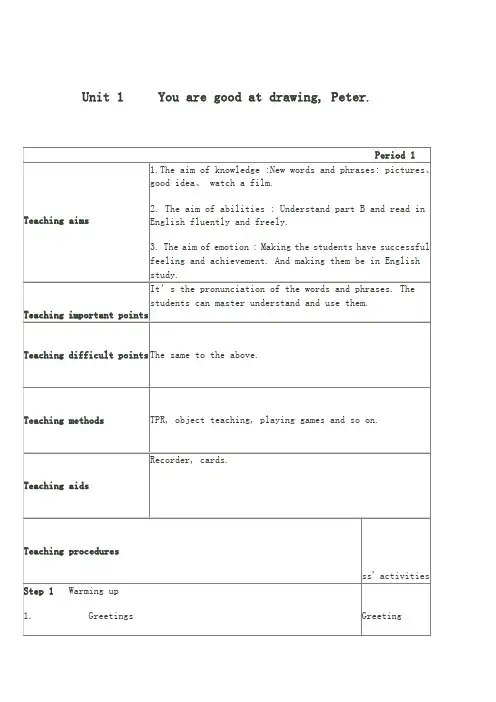
You are good at drawing, Peter.
Period 1 1.The aim of knowledge :New words and phrases: pictures、 good idea、 watch a film. 2. The aim of abilities : Understand part B and read in English fluently and freely. 3. The aim of emotion : Making the students have successful feeling and achievement. And making them be in English study. It’s the pronunciation of the words and phrases. The students can master understand and use them. Teaching important points
2. What does Mingming like doing? He likes skating. 3. What does Peter like doing? He likes drawing. 4. What do all the kids like? They like watching films. Ⅱ.Pairs work: 1. 2. 3. 4. 5. What are you good at ? What are you not good at ? What is your best friend good at ? What do you like doing? Do you like watching films? Ask and answer
新版湘少版六年级英语下册全册教案
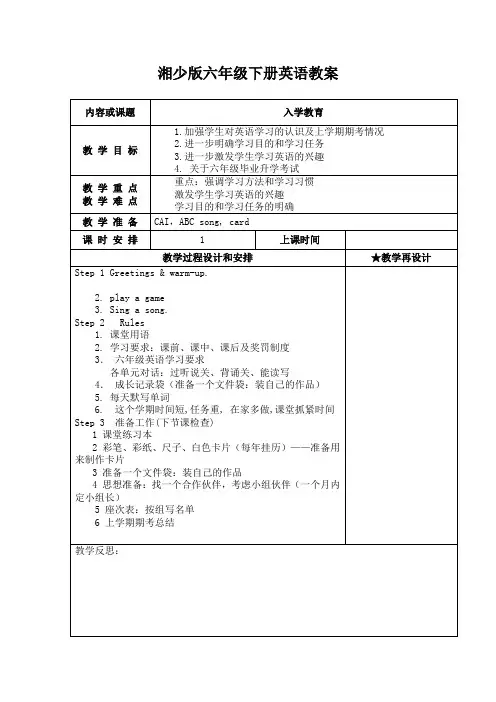
共三课时
上课时间
教学过程设计和安排
★教学再设计
Step 1 热身/复习(Warm-up/ Revision)
1.Greetings.
2.Game:Look and say教师利用课件呈现学生熟悉的家庭活动
T:She is beautiful. What is she doingSs : She is watching a movie.
各单元对话:过听说关、背诵关、能读写
4. 成长记录袋(准备一个文件袋:装自己的作品)
5. 每天默写单词
6. 这个学期时间短,任务重, 在家多做,课堂抓紧时间
Step 3 准备工作(下节课检查)
1 课堂练习本
2 彩笔、彩纸、尺子、白色卡片(每年挂历)——准备用来制作卡片
3 准备一个文件袋:装自己的作品
3.Dongdong’s family goes to the library.
Step 2新课呈现(Presentation)
about our family outings during the winter holidays.
(1)带读:Peter’s family, Anne’s family, my family.
湘少版六年级下册英语教案
内容或课题
入学教育
教 学 目 标
1.加强学生对英语学习的认识及上学期期考情况
2.进一步明确学习目的和学习任务
3.进一步激发学生学习英语的兴趣
4. 关于六年级毕业升学考试
教 学 重 点
教 学 难 点
重点:强调学习方法和学习习惯
激发学生学习英语的兴趣
学习目的和学习任务的明确
教 学 准 备
1.Greetings.
湘少版六年级英语下册全册教案
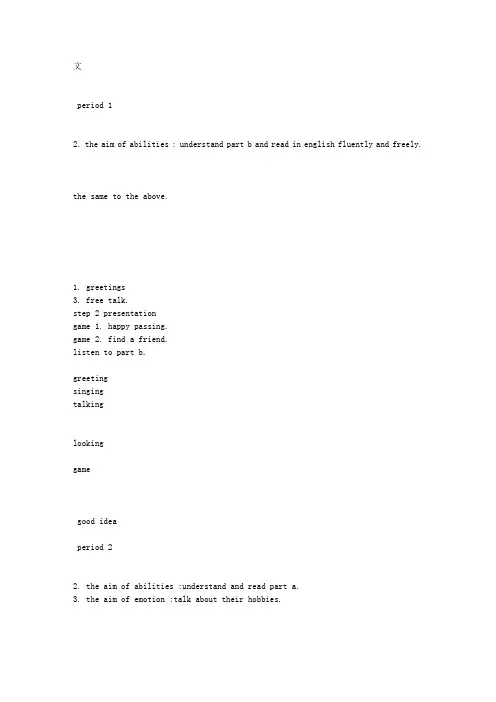
文period 12. the aim of abilities : understand part b and read in english fluently and freely. the same to the above.1. greetings3. free talk.step 2 presentationgame 1. happy passing.game 2. find a friend.listen to part b.greetingsingingtalkinglookinggamegood ideaperiod 22. the aim of abilities :understand and read part a.3. the aim of emotion :talk about their hobbies.be(not) good at+v-ingthe same to the above and listening.1. greetings.2. free talk.step 3.presentation and drill.make a example like the above:2. read part a by themselves for five minutes.3. role play part a.greetingtalking.listeningi’m not good at skating.[be(not) good at+v-ing.period 32. the aim of abilities : listen to the tape, improve the students’ listening.3. the aim of emotion :talk about their hobbies.1. greetings.2. free talk.3. role play part a.step 2. presentation1. i am good at jumping.2. i am good at playing table tennis.3. i am good at singing.4. i am good at fishing.step 5 sum upgreetingtalking.be(not) good at+vingperiod 13. the aim of emotion :the students like to study english.skating, rink, learn, fall over, fell over, keep straight,1. greeting.2. free talk.3. sing a song: do re me1. reading part a of unit 1.a. skating rinkb. learnlearn from lei feng.live and learn. 活到老,学到老fall---felld. keep straight [streit]stand up straight.e. try togame 1. guessing game: guess, guess, guessgame 2. dragon gamegame 3. monkeys see, monkeys do.listen to part b.skating, rink, learn, fall over, fell over, keep straight, try. step 6. summary.greetingtalking.readinglistening and readinggamesskating rink,learn,fall over----fell over,keep straighttry toperiod 22.the aim of abilities :understand and read part a.1. greeting.2. free talk.step 3. presentation2. understand the text.d. never mind1. listen to part a.3. read the dialogue by themselves.4. read the dialogue in groups.5. role part a.step 6. summary.greetingtalking.listeninglistenreadshe tried to skate but she fell over.never mindperiod 32.the aim of abilities : listen to the tape, improve the students’ listening.3.the aim of emotion :talk about their hobbies.lister to the tape. improve students listening.1. greetings.2. free talk.step 3. summaryread part a at home.greetingtalking.unit 3 have you got enough money?period 11. the aim of emotion :the students like to study english.1. greetings.2. free talk.3. game: gold finger.1. reading part a of unit 1 and unit2.book + store = bookstoree. g. xinhua bookstoremark [mɑ:k]dirty movies; a dirty joke.e.g. do you have enough?game 1. happy passing.listen to part b and read.step 6. summary.greetings.talking.gamereadinglistenlearnplaying gameslisten and readunit 2 have you got enough money?bookstore = book + storea dirty markusefulenoughperiod 2the aim of abilities :understand and read part a.1.greeting.2.free talk.step 3. presentation1. lead in part a.t: ten yuan. have you got enough money?s: …2.understand the text.a. have you got enough money?d. is it useful enough?e .it’s small enough.f. it’s got a dirty mark.2. read the dialogue by themselves.3. role part a.step 6. summary.greetingtalking.listeningreadingunit 3 have you got enough money?have you got enough money?is it useful enough?it’s small enough.it’s got a dirty mark.period 32.the aim of abilities : listen to the tape, improve the students’ listening.3.the aim of emotion :talk about their hobbies.part e .let’s play a game.lister to the tape. improve students listening.1.greetings.2.free talk.2. did she have enough money to buy it ?no, she didn’t.yes, she did.too (adv.)1.也。
湘少版小学六年级下册英语教案 全册
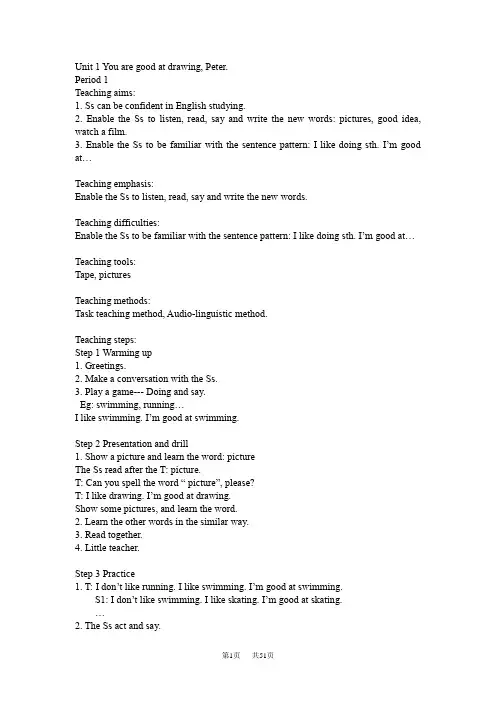
Unit 1 You are good at drawing, Peter.Period 1Teaching aims:1. Ss can be confident in English studying.2. Enable the Ss to listen, read, say and write the new words: pictures, good idea, watch a film.3. Enable the Ss to be familiar with the sentence pattern: I like doing sth. I’m good at…Teaching emphasis:Enable the Ss to listen, read, say and write the new words.Teaching difficulties:Enable the Ss to be familiar with the sentence pattern: I like doing sth. I’m good at…Teaching tools:Tape, picturesTeaching methods:Task teaching method, Audio-linguistic method.Teaching steps:Step 1 Warming up1. Greetings.2. Make a conversation with the Ss.3. Play a game--- Doing and say.Eg: swimming, running…I like swimming. I’m good at swimming.Step 2 Presentation and drill1. Show a picture and learn the word: pictureThe Ss read after the T: picture.T: Can you spell the word “ picture”, please?T: I like drawing. I’m good at drawing.Show some pictures, and learn the word.2. Learn the other words in the similar way.3. Read together.4. Little teacher.Step 3 Practice1. T: I don’t like running. I like swimming. I’m good at swimming.S1: I don’t like swimming. I like skating. I’m good at skating.…2. The Ss act and say.3. Pair-work.4. Act it out.Step 4 Consolidation1.Evaluation.2.Do Ex.3.Homework. Copy the new words.Design of the blackboard:Unit 1 You are good at drawing, Peter.pictures good idea watch a filmI don’t like running.I like swimming.I’m good at swimming.Unit 1 You are good at drawing, Peter.Period 2Teaching aims:1 .Ss can get fun from English studying.2 .Enable the Ss to listen, read and say the dialogue.3. Enable the Ss to master the sentence pattern: like doing sth, don’t like doing sth. Be good at doing…Teaching emphasis:Enable the Ss to listen, read and say the dialogue.Teaching difficulties:Enable the Ss to master the sentence pattern:like doing sth,don’t like doing sth.Be good at doing…Teaching tools:Tape, pictures, computer.Teaching methods:Task teaching method, Audio-linguistic method.Teaching steps:Step 1 Warming up1. Greetings.2. Act and say.T: I don’t like running. I like swimming. I’m good at swimming.S1: I don’t like swimming. I like skating. I’m good at skating.…Step 2 Presentation and drill1.Ask and answer:T: What do you like doing, Peter?Peter: I like reading. I don’t like singing.2. Listen to the tape and answer the questions in complete sentences.What is Anne good at?What does Mingming like doing?What does Peter like doing?What do all the kids like?3. Explain the difficulties.Step 3 Practice1. Listen to the tape and repeat.2. Read after T.3. Read together.4. Pair-work.5. Little teacher.Step 4 Consolidation1.Evaluation.2.Do Ex.3.Homework.Design of the blackboard:Unit 1 You are good at drawing, Peter.What do you like doing, Peter?I like reading.I don’t like singing.I’m good at swimming.Unit 1 You are good at drawing, Peter.Period 3Teaching aims:1.Enable the to Ss talk about themselves happily.2.Enable the Ss to make sentences about themselves;3. Educate the Ss to finish the Ex.Teaching emphasis:Enable the Ss to talk about themselves.Teaching difficulties:Enable the Ss to finish the Ex.Teaching tools:Tape, computer.Teaching method:Task teaching method, Audio-linguistic method.Teaching steps:Step 1 Warming up1. Greetings.2. Read Part A together.Step 2 Presentation and drill1. T: Now please finish Part D: Talk about ourselves.2. Check the answer.3. Ask two Ss to retell the story.Step 3 Practice1. Class work. Look at the pictures, describe what each person is doing.2. What are they doing? Write sentences about 5 of the above pictures. Write the number of the picture in each box.3. Let’s sing.4. Let’s find out and write. The children are going to the cinema to watch a film. Draw lines to show how they go to the cinema. Write sentences to show how they go there. Step 4 Consolidation1.Do Ex. Workbook Unit 1.2.Evaluation.3.Homework. Revise Unit 1.Design of the blackboard:Unit 1 You are good at drawing, Peter.I like reading.I don’t like singing.I’m good at swimming.I’m not good at swimming.Unit 2 Anne wanted to skate.Period 1Teaching aims:1.Ss can be interested in English studying.2.Enable the Ss to listen, read, say and write the new words: skating rink, learn, fall over.3.Enable the Ss to be familiar with the sentence pattern: I want to…Teaching emphasis:1.Enable the Ss to listen, read, say and write the new words.Teaching difficulties:2.Enable the Ss to be familiar with the sentence pattern: I want to…Teaching tools:Tape, pictures ,computer.Teaching methods:Task teaching method, Audio-linguistic method.Teaching steps:Step 1 Warming up1.Greetings.2.Make a conversation with the Ss:What do you like doing?What are you good at?Do you like…?3.Play a game--- Doing and say.Eg: swimming, running…I like swimming.I’m good at swimming.Step 2 Presentation and drill1. T: Do you like skating, Peter?Peter: Yes, I like skating.T: Let’s go to the skating rink, OK?(Show the picture of “a skating rink”)The Ss read after the T: a skating rink.T: Can you spell the word “skating”, please?T: I like skating. I’m good at skating .I want to skate.2. Learn the sentence pattern: I want to…I want to stand up straight.I want to put out my arms.I want to skate as well as you.3. Learn the other words by situation and actions.4. Read together.5. Little teacher.Step 3 Practice1. Situation practise.I want to…2. Pair-work.3. Act it out.Step 4 Consolidation1.Evaluation.2.Do Ex.3.Homework. Copy the new words.Design of the blackboard:Unit 2 Anne wanted to skate.skating rink learn fall overI want to stand up straight.I want to put out my arms.I want to skate as well as you.Unit 2 Anne wanted to skate.Period 2Teaching aims:1.Ss can insist on doing something in their lives.2.Enable the Ss to listen, read and say the dialogue;3.Enable the Ss to master the sentence pattern: I want to do …, and the past tense. Teaching emphasis:Enable the Ss to listen, read and say the dialogue.Teaching difficulties:Enable the Ss to master the sentence pattern: I want to do …,and the past tense. Teaching tools:Tape, pictures, computer.Teaching methods:Task teaching method, Audio-linguistic method.Teaching steps:Step 1 Warming up1.Greetings.2.Revise the words.3.Act and say.T: What do you like doing, Peter?Peter: I like running. I’m good at running.T: I don’t like running. I like swimming. I’m good at swimming. I want to go to swim.S1: I don’t like swimming. I like skating. I’m good at skating. I want to go to skate.…Step 2 Presentation and drill1.Look at the picture, ask and answer:T: What are they doing?Where are they?2. Listen to the tape and answer the questions.How to skate?3. Explain the difficulties. The past sense: went, did, said, asked, tried, fell, helped…Step 3 Practice1. Listen to the tape and repeat.2. Read after T.3. Read together.4. Pair-work.5. Little teacher.Step 4 Consolidation1.Evaluation.2.Do Ex.3.Homework.Design of the blackboard:Unit 2 Anne wanted to skate.went, did, said, asked, tried, fell, helpedUnit 2 Anne wanted to skate.Period 3Teaching aims:1.Ss can insist on doing something in their lives.2.Enable the Ss to be familiar with the past tense.3.Enable the Ss to finish the Ex in Part C, Part D, Part E and Part F. Teaching emphasis:Enable the Ss to be familiar with the past tense.Teaching difficulties:Enable the Ss to finish the Ex.Teaching tools:Tape, computer.Teaching methods:Task teaching method, Audio-linguistic method.Teaching steps:Step 1 Warming up1. Greetings.2. Make dialogues.3. Read Part A together.Step 2 Presentation and drill1. T: Now please finish Part C: About the story.Write the correct form of the verbs in the brackets.2. Check the answers.3. Read after T.Step 3 Practice1. Let’s practise: Part D.Pair work. Make a list of things you want to do this weekend. Ask and answer questions about each other’s plans for the weekend. Write down what your friend tells you.2. Let’s look and write: What does each person in the picture want to do? Use the words given to write your answers.3. Let’s listen and write.Listen to the tape carefully. Write 1 to 8 in the picture below to arrange them in order.Step 4 Consolidation1.Do Ex. Workbook Unit2.2.Evaluation.3.Homework. Revise Unit 2.Design of the blackboard:Unit 2 Anne wanted to skate.Unit 3 Have you got enough money?Period 1Teaching aims:1.Make students know use money correctly.2.Enable the Ss to listen, read, say and write the new words: a dictionary, bookstore, a dirty mark, useful.3.Enable the Ss to be familiar with the sentence pattern: Have you got enough …? Yes,I have. No, I haven’t.Teaching emphasis:Enable the Ss to listen, read, say and write the new words.Teaching difficulties:Enable the Ss to be familiar with the sentence pattern:Have you got enough …?Yes, I have. No, I haven’t.Teaching tools:Tape, pictures, computer.Teaching methods:Task teaching method, Audio-linguistic method.Teaching steps:Step 1 Warming up1.Greetings.2.Make a conversation with the Ss:What do you like doing?What are you good at?Do you like…?3.Play a game--- Do and say.Eg: swim, run…I want to go swimming.I want to go running.Step 2 Presentation and drill1. T: Do you like reading, Peter?Peter: Yes, I like reading.T: Let’s go to the bookstore, OK?(Show the picture of “a bookstore”)The Ss read after the T: a bookstore.T: Can you spell the word “ bookstore”, please?2. Learn the other words in a similar way.3. Learn the sentence pattern:Have you got enough …?Yes, I have.No, I haven’t.4. Read together.5. Little teacher.Step 3 Practice1. Situation practise.Have you…2. Pair-work.3. Act it out.Step 4 Consolidation1.Evaluation.2.Do Ex.3.Homework. Copy the new words.Design of the blackboard:Unit 3 Have you got enough …?Yes, I have. No, I haven’t.a dictionary bookstore a dirty mark usefulTeacher’s notes:Unit 3 Have you got enough money?Period 2Teaching aims:1.Make students not to spare money.2.Listen and understand the text in Part A.3.Master 4-skill words and phrases.Teaching emphasis:Listen and say the text.Teaching difficulties:Act the text in Part A out.Teaching tools:Pictures, computer, some objects( dictionaries, books), some cheque cards. Teaching methods:Communicative method, gamesTeaching steps:Step 1 Warming up1.Greetings.Class begins. Good morning. Glad to meet you. How are you? I’m fine, thanks.2.Sing a song: Follow me.3.A game: Flash cardTeacher shows pictures quickly, and make students put up hands and say out thewords on them.Step 2 Presentation1.Make students read the text by themselves for 2 minutes and think about the following questions:ⅰWhere was Anne?ⅱWhat did Anne want to buy?ⅲHas Anne got enough money?ⅳDid Anne buy it at last? Why?2.Let students answer the questions one by one.3.Listen and understand the text.4.Listen and say the text in Part A.Step 3 Practice1.A game: The lucky boxTeacher prepares a box and names it “ Lucky box”. Put some pieces of paper with sentences on them in it. Ask students choose one and read it out. If he/ she can read out, he/ she will gain one point for his/ her own side.2.Act the text by themselves in pairs.3.Ask two pairs to the front and play roles.Step 4 ConsolidationAsk students to act according to the item: Peter and Mary go to buy fruits. They want to buy apple which is 4 yuan. They haven’t got enough money and buy some bananas at last.Step 5 Assignment1.Recite the text in Part A.2.Write the 4-skill sentence for 3 times.Design of the blackboard:Unit 3 Have you got enough …?Yes, I have.No, I haven’t.Teacher’s notes:Unit 3 Have you got enough money?Period 3Teaching aims:1.Ss can have fun from English studying.2.Enable Ss know the differences betreen “too”and “enough”.3.Enable the Ss to finish the Ex in Part C, Part D, Part E and Part F.Teaching emphasis:Enable the Ss to ask and answer :Have you got enough money?.Teaching difficulties:Enable the Ss to finish the Ex.Teaching tools:Tape, computer.Teaching methods:Task teaching method, Audio-linguistic method. Teaching steps:Step 1 Warming up1. Greetings.2. Make dialogues.3. Read Part A together.Step 2 Presentation and drill1. T: Now please finish Part C: About the story.2. Check the answers.3. Read after T.Step 3 Practice1. Let’s practise: Part D.Finish the blanks with “too” “enough”.Step 4 Consolidation1.Do Ex. Workbook Unit 3.2.Evaluation.3.Homework. Revise Unit3.Design of the blackboard:Unit 3 Have you got enough money?I can’t move this box.It is too heavy.I am not strong enough.Teacher’s notes:Unit 4 Our earth looks like this from spacePeriod 1Teaching aims:1.Make students get interested in astronomy.2.Listen and say new words: interested, excitedly, Space Museume the sentence:...looks like…Teaching emphasis:Master 4-skill words and phrases: interested, excitedly, Space Museum Teaching difficulties:Use the sentence: …looks like…Teaching methods:Direct method, gamesTeaching tools:Pictures, computer, word cards , tape, towel and some water. Teaching steps:Step 1 Warming up1.Greetings.T: Class begins.T: Good morning.Ss: Good morning.T: Glad to meet you.Ss: Glad to meet you too.T: How are you?Ss: I’m fine, thanks.2.Sing a song: Twinkle, twinkle, little star3.Say a rhyme: Sun, moon and stars.4.Answer the questions: What can you see in the rhyme?Step 2 Presentation and drill1.T put the towel to water and make it wet. Then throw it to the blackboard.T: What does it look like?Learn “ look like”.Ss: It looks like a …2.Divided the whole class into two groups. One of each group throw the towel to the blackboard, and the other group say out it looks like sth. The loser will be punished.3. Look at the pictures and say the words in Part B.4.Listen and imitate Part B.1)ting rink, slipping, fall over2)Listen and imitate Part B.Step 3 Practice1.A game Patting fliesStick the word cards to the blackboard. Ask some students to come to the front. T orders and students pat the word cards. The quickest will win the game.2.A game Magic guess3.Pair work. Take turns to tell your partner what each of these things looks like.Step 4 Consolidation1.Let’s draw. Draw different shapes in the boxes below.Ask your friend what they look like.2.Feedback.3.Do exercises.Step 5 Assignment1.Copy the 4-skill phrases for 3 times.2.Prepare Part A.Desig n of the blackboard:Unit 4 Our earth looks like this from spaceIt looks like the sky. interested,excitedly,Space MuseumUnit 4 Our earth looks like this from spacePeriod 2Teaching aims:1.Make students get interested in Science.2.Understand and retell the text in Part A.3.Master the sentence “ …looks like …”.Teaching emphasis:1.Listen and retell the text.2.Revise words and sentences. Use the sentence: …looks like…Teaching difficulties:1.Understand and act out the text in Part A2. Understand and use the Past tense correctly.Teaching methods:Direct method, gamesTeaching tools:Pictures, computer, word cards, tapeTeaching methods:Direct method, gamesStep 1 Warming up1.Greetings.2.A game: Flash cardTeacher shows pictures quickly, and make students put up hands and say out the words on them.3.Ask and answerTeacher show slides: What does it look like?Ss raise their hands and answer: It looks like a …Step 2 Presentation and drill1.T make students read the text by themselves and think about the questions in Part C.2.Finish Part C.3.Listen and say the text in Part A.Step 3 Practice1.Act the text by themselves in pairs.2.Ask two pairs to the front and play roles.Step 4 Consolidation1.Let’s do and say: What do these shadows looks like?2.A game: Make shadows and guess.3.Feedback4.Do exercises.Step 5 Assignment1.Recite the text in Part A.2.Think over how to make new shadows with hands.Desig n of the blackboard:Unit 4 Our earth looks like this from spaceUnit 4 Our earth looks like this from spacePeriod 3Teaching aims:1.Ss have good imaginations.2. Master the sentence “ …looks like …”.3.Ss can finish the exercises:CDEF and in workbook.Teaching emphasis:Master the sentence “ …looks like …”.Teaching difficulties:Ss can finish the exercises:CDEF and in workbook.Teaching methods:Task teaching method, Audio-linguistic method.Teaching tools:Pictures, computer,Teaching steps:Step 1 Warming up1.Greetings.2.Sing an English song.3.Retell the story of Part A.Step 2 Presentation and drill1. T: Now please finish Part C: About the story.2. Check the answers.3. Read after T.e the correct form of verbs in the brackets.Step 3 Practice:1. Let’s practise: Part D.Pair work:Take turns to tell your partner what each of these things looks like.2.Let’s draw and ask your friend what they look like.3.Listen to the tape and write the numbers in the boxes:What these shadows look like? Step 4 Consolidation1.Recite the text in Part A.2.Think over how to make new shadows with hands.3.Finish the exercises in workbook.Desig n of the blackboard:Unit 4 Our earth looks like this from spaceWhat these shadows look like?Unit 5 There are more shops in Picture OnePeriod 1Teaching aims:1.Tell students to watch things carefully.2.Listen and say new words: fewer, more, hawkers, similar, puzzle, favourite, differente the sentences There are more/ fewer/ less….in Picture…Teaching emphasis:Master 4-skill words and phrases: fewer, more, hawkers, similar, puzzle, favourite, differentTeaching difficulties:Use the sentences: There are more/ fewer/ less……….Teaching methods:Task teaching method, Audio-linguistic method.Teaching tools:Pictures, computer, word cards , tape,Teaching steps:Step 1 Warming up1.Greetings.T: Class begins.T: Good morning.Ss: Good morning.T: Glad to meet you.Ss: Glad to meet you too.T: How are you?Ss: I’m fine, thanks.2. Sing a song: Twinkle, twinkle, little star3.Ask and answerWhat do the shadows look like?It looks like…Step 2 Presentation and drill1.T show 2 pens and ask:How many pens are there in my hand?Ss: Two.T show right hand: How many pens are there in my right hand?Ss: Three.T: There are more pens in my right hand.Teach new word more.T: There are fewer pens in my left hand.Teach the new word fewer.Teach less.2.Show slides. Ask students to talk about them with the sentences “ There are more/ fewer…in Picture…”3.Listen and imitate Part B.4.Read the words more.Step 3 Practice:1.A competition between Ga and Gb.Make students look at the pictures in P22 and talk about them. If they are right, they will get points for their groups.2.A game Magic guess3.Pair work. Take turns to tell your partner what each of these things looks like.Step 4 Consolidation1.Let’s draw and ask.2.Do exercises.Step 5 Assignment1.Copy the 4-skill phrases for 3 times.2.Prepare Part A.Desig n of the blackboard:Unit 5 There are more shops in Picture Onefewer, more, hawkers, similar,favourite, different, puzzle,Unit 5 There are more shops in Picture OnePeriod 2Teaching aims:1.Make students get interested in puzzles.2.Understand and retell the text in Part A.3.Master the sentence “ There are more/ fewer/ less…”. Teaching emphasis:1.Listen and say the text.2.Revise words and sentencesTeaching difficulties:Understand and act out the text in Part A.Teaching methods:Task teaching method, Audio-linguistic method.Teaching tools:Pictures, computer, word cards, tapeTeaching steps:Step 1 Warming up1.Greetings.2.A game: Flash cardTeacher shows pictures quickly, and make students put up hands and say out the words on them.3.Ask and answer.4.Teacher show slides.5.Ss talk about them.Step 2 Presentation and drill1.T make students read the text by themselves and fill in the blankets.2.Finish Part E3.Listen and say the text in Part A.Step 3 Practice:Talk about Part A..Step 4 Consolidation1.Let’s draw.2.Feedback3.Do exercises.Step 5 AssignmentTalk with your partners.Desig n of the blackboard:Unit 5 There are more shops in Picture OneCars People Weather Buildings Sign boards HelicoptersPicture1Picture2Unit 5 There are more shops in Picture OnePeriod 3Teaching aims:1.Ss can watch things carefully.2.Ss can understand and use the comparative degree correctly.3.Ss can finish the exercises:CDEF and in workbook.Teaching emphasis:Understand and use the comparative degree correctly.Teaching difficulties:Ss can finish the exercises:CDEF and in workbook.Teaching methods:Task teaching method, Audio-linguistic method.Teaching tools:some pictures, word cards,the tape and the recorder ,computer are the tools. Teaching steps:Step 1 Warming up1.Greetings.2.Sing the song“The more we get together, the happier we’ll be.”Step 2 Presentation and drill1.Pair work: Look at the pictures carefully and say how Picture One is different from Picture two.S1: There are more trees in Picture One.S2: There are fewer flowers in Picture Two.Step 3 Practice:1.Finish the Ex in the Part E: Look at the things inside the two refrigerators. Completethe passage below with “ less , fewer , more.”2.Finish the Ex in Part F: Look at the drawing of Frankie below.Read the sentences about his brother,Freddie, and draw that monster on the right.Step 4 Consolidation1.Recite the text in Part A.2.Draw pictures and find differences between them .3.Finish the exercises in workbook.Desig n of the blackboard:Unit 5 There are more shops in Picture OneThere are more trees in Picture One.There are fewer flowers in Picture Two.AssessmentPeriod 1Teaching aims:1.Make students get interested in English..2.Master the words and sentences in Unit 1—Unit 53.Do exercises in Assessment.Teaching emphasis:Revise the words and sentences in Unit 1--Unit 5.Teaching difficulties:Use the sentences.Teaching methods:Task teaching method, Audio-linguistic method.Teaching tools:some pictures, word cards,the tape and the recorder ,computer are the tools. Teaching steps:Step 1 Warming up1.Greetings.2.Sing togethera)Twinkle, twinkle, little starb)Follow me3.Ask and answerWhat are you good at?What did you want to do?Have you got enough money?What does it look like?Step 2 Practice1.Look at the picture and fill in the blanks with suitable words: Comb, broom, cake, soup2.Look at the pictures below. Answer the questions in complete sentences.3.Look at the picture below and write a sentence about each child.Step3 ConsolidatioFeedbackStep 5 AssignmentRevise the words and sentences in Unit 1--Unit 5.Desig n of the blackboard:AssessmentUnit 6 Some stories are more interesting than others.Period 1Teaching aims:1.Ss can be more confident in English studying.2.Ss can get the meaning of the story and understand the usage of the comparative degree in English.3.Ss can master the new words and new sentences patterns: be+ comparative degree of adjectives. Eg: be more + interesting; be better.Teaching emphasis:Master the new words and new sentences patterns: be+ comparative degree of adjectives. Eg: be more + interesting; be better.Teaching difficulties:Ss can get the meaning of the story and understand the usage of the comparative degree in English.Teaching methods:Task teaching method, Audio-linguistic method.Teaching tools:some pictures, word cards, the tape and the recorder ,computer are the tools. Teaching steps:Step 1 Warming up1.Greetings.2.Sing an English song :Sing together.Step 2 Presentation and drill1.Show some pictures and ask some Ss to describe them or answer the teacher’s questions.T: What is it in Picture One ? How do you think about it?Is it interesting? Which one is better ,Picture One or Picture Two?Ss answer and describe them.2.Learn to say new words: better, interesting, exciting.3.Learn to say new patterns: Be + comparative degree of adjectives.Be better; be more interesting ; be more exciting.4.Learn to say the new sentences patterns:Picture One is better than Picture Two.Picture Two is more interesting than Picture One.Swimming in the sea is more exciting than swimming in a pool. ( It is more exciting swimming in the sea than swimming in a pool.)Step 3 Practice:1. Finish the Ex in Wb plete the sentences: more interesting ; more dangerous; more exciting.2. Listen to the tape and get the meaning of the story. Write down the sentences patterns of comparative degree.Step 4 Consolidation:1.Read the new words and sentences patterns.2.Make sentences about the comparative degree.Eg: It is more exciting riding a motorcycle than riding a scooter.It is more dangerous climbing a mountain than climbing a hill.3.Homework:Write and read the new words and sentences.Design of the blackboard:Unit 6 Some stories are more interesting than others.be better; be more interesting ; be more exciting.Swimming in the sea is more exciting than swimming in a pool.It is more exciting swimming in the sea than swimming in a pool.Unit 6 Some stories are more interesting than others.Period 2Teaching aims:1.Ss can be more confident in English studying.2.Ss can get the meaning of the story and understand the usage of the comparative degree in English.3.Ss can master the new words and new sentences patterns: be+ comparative degree of adjectives. Eg: be more + interesting; be better.Teaching emphasis:Master the new words and new sentences patterns: be+ comparative degree of adjectives. Eg: be more + interesting; be better.Teaching difficulties:Finish the Ex in book about the comparative degree.Teaching methods:Task teaching method, Audio-linguistic method.Teaching tools:some pictures, word cards, the tape and the recorder ,computer are the tools. Teaching steps:Step 1 Warming up1.Greetings.2.Sing some English songs.3.Report.It is Tuesday today. It is fine. Everyone is here.We love English.。
新版湘少版六年级英语下册全册教案
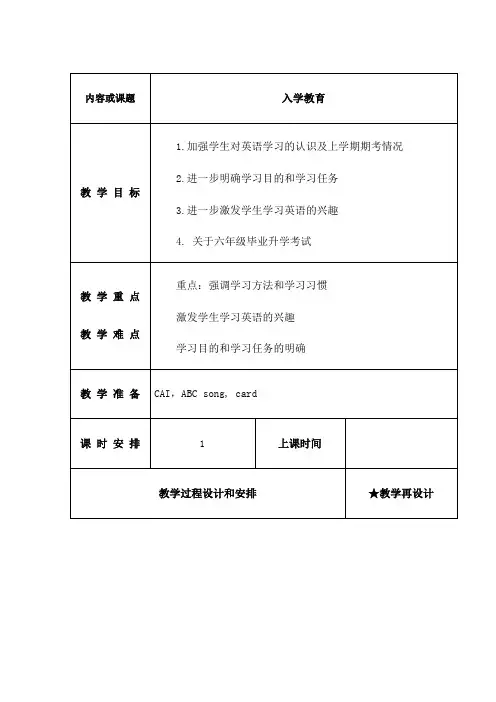
教 学 难 点
重点:掌握并运用句型“A is /are more …than B”,;理解、阅读本课故事。难点:复述本课故事
教 学 准 备
Word cards, Type,CAI, Drawing Instrument
课 时 安 排
共三课时
上课时间
教学过程设计和安排
★教学再设计
Step 1 warm-up
教学重点
教学难点
1.重点:能听懂、会说、认读新单词beach, restaurant, ourselves。
2.难点:阅读内容较多,句式复杂,新版教材学生还需适应。
教 学 准 备
Word cards, Type,CAI, Drawing Instrument
课 时 安 排
共三课时
上课时间
教学过程设计和安排
教 学 重 点
教 学 难 点
1、重点:能听懂、会说、认读新单词能听懂、会说、认读新单词outing,movie,together。能运用句型询描述家庭郊游“We’ll watch a movie.”
2、难点:will在一般将来时态的用法。
教 学 准 备
Word cards, Type,CAI, Drawing Instrument
A is taller than B 然后学生指名谈论教室里的人或物.
2T : CAI Look at this picture ,Do you know who he is ?
内容或课题
入学教育
教 学 目 标
1.加强学生对英语学习的认识及上学期期考情况
2.进一步明确学习目的和学习任务
3.进一步激发学生学习英语的兴趣
4. 关于六年级毕业升学考试
新湘少版小学六年级下英语全册教案
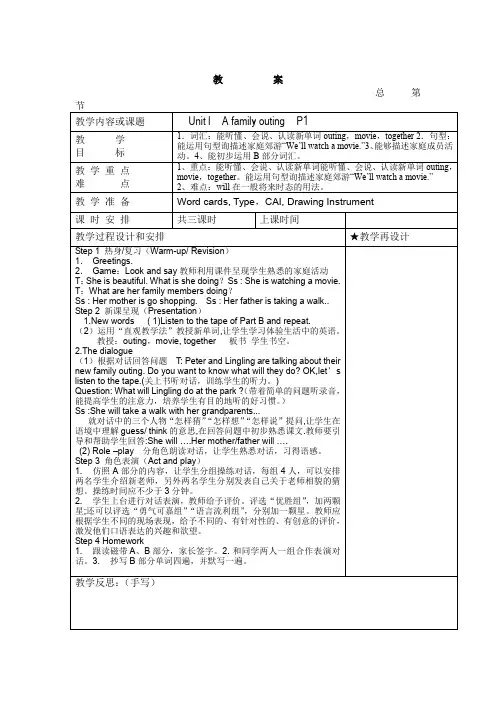
教案总第教案总第教案总第教案教案总第教案教案教案总第教案总第教案总第教案总第总第教案总第教案总第教案总第Unit 6 Anne wanted to dancePeriod 1一、教学目标(一)语言目标:1.能听懂、会说、认读词组dancing room, move with the music, put arms out, step on one’s foot 等。
2.句型:能在情境中正确,灵活的运用“want to do something”表达人物的意愿。
(二)应用目标1. 能在教师的引导下完整的阅读和理解课文A部分的故事2. 能在读懂故事的基础上领悟故事的内涵和道理;培养学生克服困难的勇气和乐于助人的优良品质。
3. 能听懂、会说A部分的课文。
二、教学重点及难点教学重点:1.调动学生的思维,理解本文,并挖掘出文本的内涵。
教学难点:1,用英语说出自己克服困难的某次经历。
三、教学准备教学VCD,教学PPT。
四、教学步骤Step 1 Warming up1.头脑风暴教师问学生的爱好,学生纷纷说出自己的爱好,激活原有的背景知识,熟悉文本中的部分语言和知识点。
让学生尽可能读的罗列与本主题相关的信息。
T:What’s you hobby?S:I like singing.S2:I like painting.………T: I like dancing ,but I’m not good at it.Are you good at dancing?S:Yes,I amT: Can you show me?T:You can dance very well.I want to dance like you.Can you teach me? S:OK!教师请学生师范,大家跟着一起学习做动作。
老师可以配上相应的英语说,并板书在黑板上。
Step 2 Presentation1. Pre—reading(1)预测:看图说话老师出示三幅教学挂图,并提出问题,让学生根据已有的信息对文章的内容进行预测。
新版湘少版六年级英语下册全册教案
共三课时
上课时间
教学过程设计和安排
★教学再设计
Step 1 热身/复习(Warm-up/ Revision)
1.Greetings.
2.Game:Look and say教师利用课件呈现学生熟悉的家庭活动
T:She is beautiful. What is she doingSs : She is watching a movie.
CAI,ABC song, card
课 时 安 排
1
上课时间
教学过程设计和安排
★教学再设计
Step 1 Greetings & warm-up.
2. play a game
3. Sing a song.
Step 2 Rules
1.课堂用语
2.学习要求:课前、课中、课后及奖罚制度
3. 六年级英语学习要求
4 思想准备:找一个合作伙伴,考虑小组伙伴(一个月内定小组长)
5 座次表:按组写名单
6 上学期期考总结
教学反思:
六年级下期英语教案
内容或课题
Unit l A family outing P1
教 学 目 标
1.词汇:能听懂、会说、认读新单词outing,movie,together 2.句型:能运用句型询描述家庭郊游“We’ll watch a movie.”3、能够描述家庭成员活动。4、能初步运用B部分词汇。
教学重点
教学难点
1.重点:能听懂、会说、认读新单词beach, restaurant, ourselves。
2.难点:阅读内容较多,句式复杂,新版教材学生还需适应。
教 学 准 备
Word cards, Type,CAI, Drawing Instrument
新版湘少版六年级英语下册全册教案
新版湘少版六年级英语下
册全册教案
The pony was revised in January 2021
六年级下期英语导学案
六年级下期英语导学案
六年级下期英语导学案
六年级下期英语导学案
六年级下期英语导学案
六年级下期英语导学案
六年级下期英语导学案
六年级下期英语导学案
六年级下期英语导学案
六年级下期英语导学案
六年级下期英语导学案
六年级下期英语导学案
六年级下期英语导学案
六年级下期英语导学案
六年级下期英语导学案
六年级下期英语导学案。
新版湘少版六年级英语下册全册教案
教 学 难 点
1、重点:能听懂、会说、认读新单词能听懂、会说、认读新单词outing,movie,together。能运用句型询描述家庭郊游“We’ll watch a movie.”
2、难点:will在一般将来时态的用法。
教 学 准 备
Word cards, Type,CAI, Drawing Instrument
(2)运用“直观教学法”教授新单词,让学生学习体验生活中的英语。
教授:outing,movie, together 板书 学生书空。
dialogue
(1)根据对话回答问题 T: Peter and Lingling are talking about their new family outing. Do you want to know what will they do OK,let’s listen to the tape.(关上书听对话,训练学生的听力。)
S1 : Yes, he is taking a walk.
S2: No, she is going shopping.
S3 : …. …
2.口头作文
3.根据写作辅助模块1或课文模块,自主写作。
. My family usually goes to park at weekends.
My family usually goes to park and supermarket.
T:What are her family members doing
Ss : Her mother is go shopping. Ss : Her father is taking a walk..
Step 2 新课呈现(Presentation)
新版湘少版六年级英语下册全册教案
共三课时
上课时间
教学过程设计和安排
★教学再设计
Step 1热身/复习(Warm-up/ Revision)
1.Greetings.
2.Game:Look and say教师利用课件呈现学生熟悉的家庭活动
T:She is beautiful. What is she doing?Ss : She is watching a movie.
教学重点
教学难点
重点:掌握并运用句型“A is /are more …than B”,;理解、阅读本课故事。难点:复述本课故事
教学准备
Word cards, Type,CAI, Drawing Instrument
课时安排
共三课时
上课时间
教学过程设计和安排
★教学再设计
Step 1 warm-up
1、师生互相问候。
Question: What will Lingling do at the park ?(带着简单的问题听录音,能提高学生的注意力,培养学生有目的地听的好习惯。)
Ss :She will take a walk with her grandparents...
就对话中的三个人物“怎样猜”“怎样想”“怎样说”提问,让学生在语境中理解guess/ think的意思,在回答问题中初步熟悉课文.教师要引导和帮助学生回答:She will ….Her mother/father will ….
课时安排
1
上课时间
教学过程设计和安排
★教学再设计
Step 1 Greetings & warm-up.
1.Greetings
2. play a game
3. Sing a song.
- 1、下载文档前请自行甄别文档内容的完整性,平台不提供额外的编辑、内容补充、找答案等附加服务。
- 2、"仅部分预览"的文档,不可在线预览部分如存在完整性等问题,可反馈申请退款(可完整预览的文档不适用该条件!)。
- 3、如文档侵犯您的权益,请联系客服反馈,我们会尽快为您处理(人工客服工作时间:9:00-18:30)。
小学六年级英语下册教学计划一、教学目标:1.根据实物、图片说出所学单词要求读音正确。
2.能比较熟练地运用所学的日常交际用语。
3.能在非语言提示的帮助下,听懂清晰的话语和录音。
4.能演唱已学过的英语歌曲,诵读已学过的歌谣.二、学情分析:学生接触英语三年了,大部分学生对英语有比较浓厚的学习兴趣,但也有少数学生由于遇到困难,学习习惯也不太好,有待于端正学习态度,掌握良好的学习方法。
所以,在教学中,教师应该以学生的发展为宗旨,以培养学生的创新精神和实践能力为重点,面向全体学生,始终把激发学生的学习兴趣放在首位。
三、教材分析:六年级教材的特点:内容比较多,情景性强,语言知识点多,但是,它们都是在学生原有知识上的扩展。
所经我们在教学时要注意联系学生已有的知识,由旧知识切入新知识的学习,由旧引新,温故而知新,这样才有利于学生的理解、记忆。
四、教学措施:1.课堂教学要以学生为主体,充分发挥学生的积极性、主动性。
2.以课标理念指导教学,突出英语学科的人文性、工具性特点。
3.力求质量为先,面向全体学生,以训练促思维,促英语水平的提高,充分保证学生的自主、自学时间。
4.强化口语、听力训练,尽心辅导。
5.形成性评价列入学业学习评价,按照20% 的学习行为和口语学习评价,80%的双基评价。
以促进学生的学习为主要目的。
6.单元卷练习:任务,可以提前完成,或者同伴合作。
目的在于考核语言的掌握和兴趣的维持,不给学生太大的压力。
7.期末评价原则是:重兴趣,重双基,促能力。
Unit 1 A family outing Period 1一、教学目标(Teaching Aims)1、知识目标(Knowledge Aims):1) 能看懂、会读、会说新单词together, ride, grandparents;2) 学习、运用新句型:Shall we? We’ll?2、能力目标(Ability Aims):1) 能向他人询问、回答出行计划;2) 能理解课本A与B部分。
3、情感目标(Emotion Aims)学会小组合作,团结友爱。
二、教学重难点(Teaching Focus & Difficulties)1) 重点:理解并运用生单词;2) 难点:运用新句型。
三、课前准备(Preparation for Class)课件、图片、卡片、教学录音等等。
四、教学过程(Teaching Process)Step one: warming up1. Greetings.2. Free talk. Talk about their experiences in winter holiday. Step two: presentationIntroduce new words and phrases.T: Do you want to do these things? Watch a movie? Go shopping? Take/ have a walk? Look at the flowers? I think, it is happy for us to do things together.Play games. I do, you say. Then I say, you do.The dialogue.Listen and find out who they are.Listen and read. Answer the question: what are Lingling’s family going to do?Listen and repeat.Listen and act.Step three: consolidation1. Talk about what you are going to do this evening.2. Talk about your plans to travel at weekend with your partner and act it out.Step four: homework1. Listen and read Part A and B.2. Copy the new words three times.五、板书设计(Blackboard Design)Unit 1 A family outingtogetherridegrandparents教学反思:Period 2一、教学目标(Teaching Aims)1、知识目标(Knowledge Aims):1) 能看懂、会读、会说新单词together, ride, grandparents;2) 学习、运用新句型:Shall we? We’ll?2、能力目标(Ability Aims):1) 能向他人询问、回答出行计划;2) 能理解课本D部分的阅读内容。
3、情感目标(Emotion Aims)学会小组合作,团结友爱。
二、教学重难点(Teaching Focus & Difficulties)1) 重点:理解并运用生单词;2) 难点:运用新句型。
三、课前准备(Preparation for Class)课件、图片、卡片、教学录音等等。
四、教学过程(Teaching Process)Step one: warming up1. Greetings.2. Free talk. Talk about what you are going to do with your family outside.(Blackboard Design)Unit 1 A family outingMy family goes to?五、板书设计教学反思:Period 3一、教学目标(Teaching Aims)1、知识目标(Knowledge Aims):1) 能看懂、会读、会说新单词together, ride, grandparents;2) 学习、运用新句型:Shall we? We’ll?2、能力目标(Ability Aims):1) 能向他人询问、回答出行计划;2) 能运用所学句型、单词进行简单的写作。
3、情感目标(Emotion Aims)学会小组合作,团结友爱。
二、教学重难点(Teaching Focus & Difficulties)1) 重点:理解并运用生单词;2) 难点:运用新句型。
三、课前准备(Preparation for Class)课件、图片、卡片、CAI等等。
四、教学过程(Teaching Process)Step one: warming up1. Greetings.2. Free talk: tell us what your family usually does at home? Where does your family go outing?Step two: presentation1. What does your family usually do at weekends? Say something about it. Do you like it? How often? Write it down.2. Where does your family usually go at weekends? The park? The shopping center? Write it down.3. What do you like doing with your family most? Eating food? Taking a walk? Write it down.Step three: consolidation1. Group work: ask your partner: what is your family outing?2. Action show: find some partners to show one of your happiest outing experiences with your family. Students can vote for the interesting one. Step four: homework1. Try to write down your family outing.2. Finish the exercises of Unit 1.五、板书设计(Blackboard Design)Unit 1 A family outingWhat does your family usually do on weekends?Where does your family usually go on weekends?What is your favorite thing to do with family?教学反思:Unit 2 Some stories are more interesting Period 1一、教案目标1、学习本课新单词a piece of, meat ,cross, eat, happily, its, wood, drop, lose, better2、能掌握并用句型“A is /are more ?than B”,对两事物进行比较。
3、能听懂、理解本课故事。
4 、会用like doing more than doing 5通过本课的语言故事,使学生明白做人不要过于贪心的道理。
二、教学重点难点重点:掌握并运用句型“A is /are more ?than B”;理解、阅读本课故事。
难点:复述本课故事三、教学准备Word cards, Type,Drawing Instrument学生齐读课题后,教师引导学生理解课题的含义。
T: His father was a friendly butcher . One day, he cut a piece of meat andgave it to a poor dog .The dog was happy.But after a while , its meat dropped into the river .Do you know why?教师用出示图片,教学单词, 利用图片帮助学生理解单词的含义并引导学生猜测原因,培养学生的发散性思维能力,同时为本课的寓言故事埋下伏笔。
2、听课文B部分录音,学生跟读单词。
Step 3 Practice游戏1、Guess ,guess ,guess !(猜一猜)首先,教师示范做动作,其他学生猜单词,然后分组进行比赛,猜对单词最多、最快的一组为胜。
最后组内互相猜测,尽量做到全员参与。
